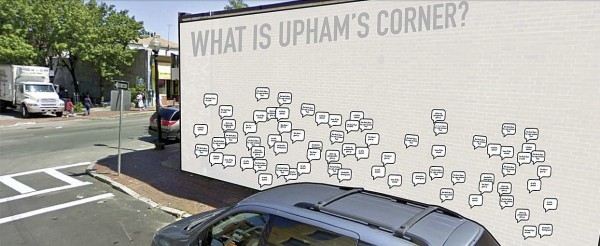Community Innovation Lab: Mashups of Youth, Activists, Technologists, Policymakers

If you seek examples of civic engagement by young people, look no further than the Community Innovation Lab, a mashup of Harvard students and faculty, the city of Boston, and established neighborhood associations. The core of this town-gown-local government hybrid is a course jointly taught by Harvard Graduate School of Design professor Michael Hooper and Harvard Kennedy School professor Susan Crawford. The Lab is the activist portion of the course, which also includes weekly seminars taught separately by each professor. Crawford’s syllabus on ”Solving Problems Using Technology" and Hooper’s syllabus on “Advanced Workshop in Participatory Urban Planning and Design,” like the components of the Lab, are both separate and intermingled. Students also meet weekly with community partners and the Mayor’s Office. Video recordings, presentations, photos and other media of the seminars are posted after each class meeting on the Videos & Class Media page.
I had known Crawford from her longstanding role convening the OneWebDay celebration. In 2009, she served as President Obama’s Special Assistant for Science, Technology, and Innovation Policy. Whenever the intersection of technology geekery and policy wonkery generates bewildering threats regarding net neutrality and digital copyright, Crawford is consistently the clearest and most well-informed voice.
I asked Crawford about the Lab as a multi-institutional hybrid. She explained that the Harvard courses are meant to result in measurable positive outcomes in real neighborhoods, through a collaboration of three neighborhood associations, students at both Harvard’s Graduate School of Design and Kennedy School of Government, and the City of Boston Mayor’s Office of New Urban Mechanics, which promised to implement the best of the student-neighborhood projects. The Knight Foundation “has indicated strong interest in funding this implementation effort.” So the Lab is still in its early stages, but does seem to include many ingredients for success.
Crawford emphasized that while her students were looking for ways to use technology to help solve real-world problems, the projects had to emerge from close collaboration with neighborhood associations around questions such as, “How can the Orchard Gardens Residents Association become a stronger political actor in the city? How can communities like the Dudley area more effectively participate in city planning efforts when these affect them? How can youth involved in the Dudley Street neighborhood more effectively participate in city planning efforts when these affect them?”
In our nine-minute video interview, Crawford and I talk about how the projects are progressing and ways in which the Lab’s successes might scale and seed similar city-student-neighborhood-technology mashups in other places.
Community Innovation Lab: Mashups of Students, Activists, Designers, Technologists, Policyshifters from DML Research Hub on Vimeo.
Banner image credit: Susan Crawford